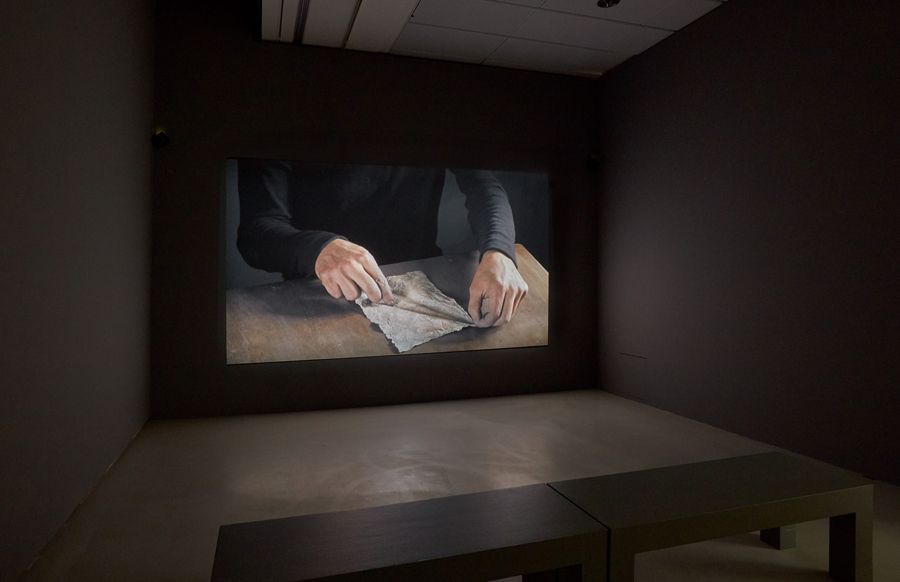From the poetic to the political
Jean-François Bouthors
Revue Esprit
July 11, 2017
Translated from French by Hana Barhoumi
Link to the article
Link to the exhibition Instruments
There are many ways to measure the world we live in. In the midst of the relentless information flow surrounding us, tuning into the radio, a TV channel, or connecting to a social network consistently provides us with glimpses of what's going on around us. It's how we keep up with the latest political, social, economic, and cultural news. We could discuss the relevance of this method, its limits and its biases. Ismaïl Bahri is careful not to do so. The work he presents at the Jeu de Paume this summer takes the exact opposite approach, with eight videos brought together under the title Instruments.

Ismaïl Bahri was born in Tunis in 1978, and is now residing and working in France and Tunisia. His "instruments" aim "to intensify human awareness of the world around us, and to awaken, through their use, new forms of critical distance", as Marta Gili, director of the Jeu de Paume, writes in the foreword to the exhibition catalog.
These instruments might be described as poetic, meditative, or spiritual, inviting the viewer to take the time to observe a phenomenon initially thought to be grasped at a glance. The images, which seem, if not unchanging, then at least stable, reveal their content and meaning only if we take the time to submit to the duration during which they transform, almost imperceptibly. Contrary to what is increasingly common in the media, we must be wary of anticipating and concluding before the unfolding process has reached its conclusion and produced effects that are both intelligible and emotional. Time must elapse before the viewer's eyes for the work to fully reveal itself, which means exposing ourselves to the flow of time to be truly "marked" by what we observe.
Not only does the duration matter, but also the material. The simplest of objects, such as a drop of water on a forearm, a taut thread, a blank page subjected to the effects of the wind, a flow of sand, a glossy photo crumpled by hands, prove capable of inspiring meditation, poetic or spiritual expression. Nothing could be more trivial, nothing more concrete than these objects, which in principle are not intended to hold our attention. But this "pause on matter", in contrast to the realm of ideas and concepts, operates with a "dazzling simplicity" (Jean-Christophe Bailly, in the exhibition catalog) creating a radical suspension, a withdrawal of discourse, that unveils the spiritual presence symbolized by the image. Operating like a psychoanalyst's silence that enables daydreaming and free association of ideas, the image becomes a silent mirror reflecting the viewer's mind. From then on, the simplest reality reveals a depth in the viewer that we never knew existed. It manifests a reflective power. The viewer can, in some way, see themselves in it and decipher an imprint of the world - near or far - on them. Ismaïl Bahri's "instruments" offer tools for a unique self awareness and understanding of the world, different from the ordinary exchanges we have about current events...
Though seemingly independent, these instruments engage in a silent conversation in the Jeu de Paume installation, encouraging viewers to move between them and simultaneously follow the evolution of multiple videos. Processes intertwine as the viewer wanders through the exhibition: palpitating, unwinding, flowing, crumpling, rewinding, consuming, floating... The viewer should not only take their time, but should also come and go in this space, in order to progressively widen their plane of vision... This discreet interweaving of experiences enhances perceptions and modes of thought without resorting to explicit discourse.
The "last" work (Foyer) - the video at the end of the tour, but not the most recent - serves as a mise en abyme, recording the effect of its surroundings. A sheet of white paper is placed in front of a camera lens, just a few centimeters away, and occupies the entire field of vision, subject to the wind. Its installation naturally provokes questions and discussions in a public space, which the device records along with the shaking of the sheet and changes in the light. The speech we hear becomes the subject of observation and also anticipates the inner conversation that may arise in the spectator, since we are placed, after all, in the same situation as he is. The echoes it elicits in the listener reflect the mysterious, incongruous, and strange nature of the device.
Ismaïl Bahri does not claim to provide a new explanation of the world. Nor does he seek to compete with current events and their discourses. In his own way, he proposes a distance from the flow, by creating a space of critical freedom. He offers up the possibility of another more contemplative and poetic dimension into our perception and understanding of our world. Ismaïl Bahri seems to remind us of the need to distance ourselves from our common ways of grasping reality. A departure that involves taking the time to look, but also to listen, without prejudgement. It's a gap that requires us to relate our various experiences to one another. A space that also allows us to put things into perspective, acknowledging our shared participation.
These days, this poetic approach may also hold political significance. Isn’t rediscovering the thickness of time, matter, and even speech what politics lacks most? Of course, Ismaïl Bahri's proposal stands outside the political sphere and its discourses, but is it not a political act to propose a broadening of our capacities for perception and symbolization in the field of culture? Doesn’t this act, however modestly, contribute to undoing the stranglehold of the politics and media in our world?